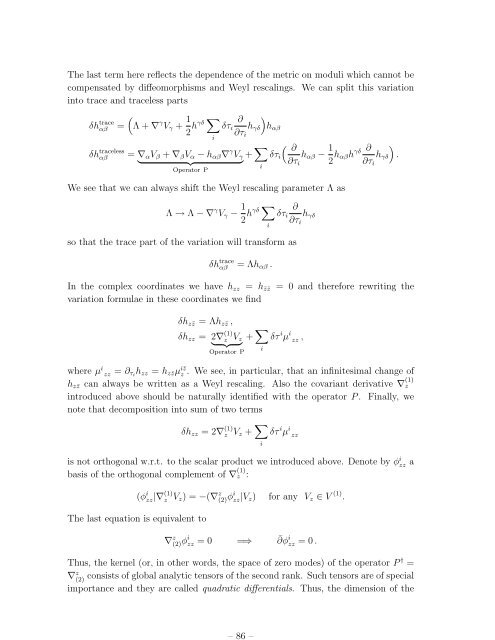Lectures on String Theory
Lectures on String Theory
Lectures on String Theory
You also want an ePaper? Increase the reach of your titles
YUMPU automatically turns print PDFs into web optimized ePapers that Google loves.
– 86 –<br />
The last term here reflects the dependence of the metric <strong>on</strong> moduli which cannot be<br />
compensated by diffeomorphisms and Weyl rescalings. We can split this variati<strong>on</strong><br />
into trace and traceless parts<br />
(<br />
δh trace<br />
αβ = Λ + ∇ γ V γ + 1 ∑ 2 hγδ i<br />
δh traceless<br />
αβ<br />
δτ i<br />
∂<br />
∂τ i<br />
h γδ<br />
)<br />
h αβ<br />
= ∇ α V β + ∇ β V α − h αβ ∇ γ V<br />
} {{ } γ + ∑ i<br />
Operator P<br />
( ∂<br />
δτ i h αβ − 1 ∂τ i 2 h αβh γδ ∂ )<br />
h γδ .<br />
∂τ i<br />
We see that we can always shift the Weyl rescaling parameter Λ as<br />
Λ → Λ − ∇ γ V γ − 1 2 hγδ ∑ i<br />
δτ i<br />
∂<br />
∂τ i<br />
h γδ<br />
so that the trace part of the variati<strong>on</strong> will transform as<br />
δh trace<br />
αβ = Λh αβ .<br />
In the complex coordinates we have h zz = h¯z¯z = 0 and therefore rewriting the<br />
variati<strong>on</strong> formulae in these coordinates we find<br />
δh z¯z = Λh z¯z ,<br />
δh zz = 2∇ (1)<br />
z V<br />
} {{ } z + ∑<br />
Operator P<br />
i<br />
δτ i µ i zz ,<br />
where µ i zz = ∂ τi h zz = h z¯z µ i¯z<br />
z . We see, in particular, that an infinitesimal change of<br />
h z¯z can always be written as a Weyl rescaling. Also the covariant derivative ∇ (1)<br />
z<br />
introduced above should be naturally identified with the operator P . Finally, we<br />
note that decompositi<strong>on</strong> into sum of two terms<br />
δh zz = 2∇ (1)<br />
z V z + ∑ i<br />
δτ i µ i zz<br />
is not orthog<strong>on</strong>al w.r.t. to the scalar product we introduced above. Denote by φ i zz a<br />
basis of the orthog<strong>on</strong>al complement of ∇ (1)<br />
z :<br />
(φ i zz|∇ (1)<br />
z V z ) = −(∇ z (2)φ i zz|V z ) for any V z ∈ V (1) .<br />
The last equati<strong>on</strong> is equivalent to<br />
∇ z (2)φ i zz = 0 =⇒ ¯∂φ<br />
i<br />
zz = 0 .<br />
Thus, the kernel (or, in other words, the space of zero modes) of the operator P † =<br />
∇ z (2)<br />
c<strong>on</strong>sists of global analytic tensors of the sec<strong>on</strong>d rank. Such tensors are of special<br />
importance and they are called quadratic differentials. Thus, the dimensi<strong>on</strong> of the

















